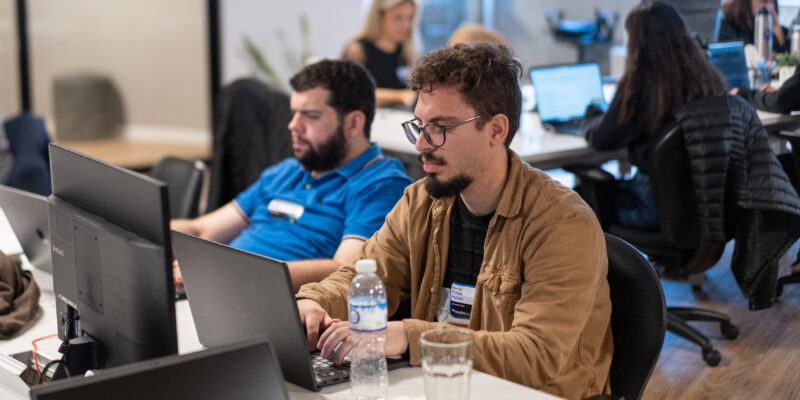
As we move deeper into 2025, US businesses are navigating unprecedented economic headwinds. With inflation still looming, consumer spending contracting, and the very real threat of economic stagnation, engineering leaders and executives are being forced to make hard decisions. And in the world of software development, where top-tier engineering talent often comes with sky-high salaries and extended hiring timelines, the pressure is even greater.
But this isn’t just a problem—it’s also an opportunity. To stay competitive while trimming costs, many companies are rethinking two core areas:
- Leveraging nearshore AI talent to reduce payroll expenses without sacrificing quality.
- Adopting AI-powered automation trends to streamline internal operations, boost productivity, and minimize overhead.
In this blog post, we’ll examine the current economic landscape and share expert insights. Then, we’ll look at how nearshore AI talent presents a cost-effective, high-performance alternative to costly domestic hiring — and how AI-powered automation is transforming the way software companies build, scale, and innovate amid economic uncertainty.
Uncertainty at the Center of US Business Strategy
Inflation, which has remained stubbornly high since the post-COVID era, is again under scrutiny. Consumer spending is down, global markets are in freefall, and recession warnings are no longer just speculation—they’re taking center stage in boardrooms and brokerage reports alike.
This year began with cautious optimism. Inflation was finally cooling thanks to the Fed’s careful monetary policy. Fed Chair Jerome Powell was widely praised for navigating a “soft landing” that avoided a full-blown recession. But the calm didn’t last.
In early April, the Trump administration implemented sweeping tariffs—blanket 10% duties on nearly all US trading partners, with some Southeast Asian manufacturers facing rates as high as 49%. This aggressive protectionist stance has caused massive volatility, wiping over $10 trillion from the global stock market in just a few days. Financial giants like JP Morgan and Goldman Sachs have since updated their forecasts.
- JP Morgan increased its estimated likelihood of a 2025 US recession from 40% to 60%.
- Goldman Sachs followed suit, revising its forecast to reflect a 45% recession probability.
The economic landscape has dramatically shifted over the past few weeks. With newly imposed tariffs sending shockwaves through international trade and investor confidence, US-based companies—especially in tech—are bracing for turbulence. Software companies, in particular, are in the eye of the storm: they are capital-intensive, reliant on high-cost technical talent, and deeply connected to global supply chains.
Fed Chair Jerome Powell, is now under pressure to adjust interest rates once again. Analysts at Goldman Sachs and RBC expect up to three rate cuts this year, as the Fed looks to stabilize an increasingly fragile economic environment.
But even if rates drop, the cost of maintaining large in-house engineering teams remains high. Many tech leaders are re-evaluating their staffing models and operational expenditures to weather what could be a prolonged economic slowdown.
In this environment, AI-powered automation and nearshore AI talent aren’t just strategic advantages—they’re necessities. The next sections will break down exactly how these solutions help US software companies maintain momentum, reduce costs, and build resilience without compromising on innovation.
Hiring Nearshore AI Talent
As the US economy teeters on the edge of a potential recession, hiring top-tier software engineers in major tech hubs like San Francisco, New York, or Austin has become unsustainable. Payroll remains one of the largest operational expenses for software companies—especially when recruiting talent skilled in emerging technologies like AI and machine learning.
This is where nearshore AI-proficient talent comes into play. By sourcing developers from nearby regions like Latin America, companies can maintain technical excellence while slashing overhead costs. And when that talent is trained in using AI-powered automation tools like GitHub Copilot or OpenAI APIs, the value becomes exponential.
The Cost-Effectiveness of Nearshore AI Talent
AI-powered development platforms are redefining how code is written, debugged, and deployed. Engineers who know how to prompt these systems correctly and integrate AI into product pipelines can build faster, reduce bugs, and ship features in a fraction of the time.
What’s more, hiring nearshore engineers—especially those proficient in AI—can cut costs by up to 50% compared to their US counterparts. For example, a senior US-based engineer typically costs around $12,000 per month in salary and benefits. Meanwhile, a nearshore developer with similar experience and stronger AI tool fluency can deliver equal (or better) output for approximately $6,000/month.
And these aren’t junior coders fresh out of bootcamp. We’re talking about engineers fluent in English, aligned with US time zones, and battle-tested in projects involving advanced automation, scalable cloud solutions, and AI integrations.
Let’s be clear: not all developers are created equal—and in 2025, those who master AI tools represent the new elite. A nearshore developer skilled in these tools can outperform a traditional developer—not because they work more hours, but because they work smarter. AI acts as a force multiplier, and the cost advantage of nearshoring only amplifies the ROI.
Your Strategic Partner in LATAM AI Talent
At BEON.tech, we specialize in connecting US firms with top-tier AI talent from Latin America. These developers are not only deeply technical but also culturally aligned with US teams, familiar with Agile methodologies, and well-versed in cutting-edge AI-powered automation trends.
BEON.tech screens for more than just code quality—they assess adaptability, communication skills, and AI readiness. That means your nearshore engineers won’t just write good code; they’ll actively contribute to your strategic initiatives, helping automate testing pipelines, optimize DevOps processes, or even co-pilot with AI to accelerate delivery. Want to talk about how we can help you cut costs by $200,000/year? Get in touch.
Implementing AI-Powered Automation Solutions
In 2025, automation isn’t just a line item in your tech stack—it’s the infrastructure of scale. As economic pressure mounts, companies are being pushed to rethink not only how they operate but what can be done faster, smarter, and more sustainably. And increasingly, the answer lies in AI-powered automation.
The evolution from basic task automation to intelligent systems powered by AI and machine learning is transforming industries at every level. This shift goes beyond efficiency—it enables real-time decision-making, reduces human error, and creates space for teams to focus on what actually drives value.
From Task Automation to Intelligent Automation
Unlike traditional automation that simply executes rules, AI-driven tools adapt to data, recognize patterns, and make decisions. Think less about replacing tasks—and more about reimagining workflows.
Platforms like UiPath, Automation Anywhere, and IBM Watson are already powering use cases from customer support to predictive maintenance. Financial institutions are using AI for real-time fraud detection. Healthcare providers are improving diagnostics and treatment planning. And in retail, AI is driving everything from personalized recommendations to real-time inventory management.
This isn’t just an efficiency upgrade—it’s a strategic shift.
Hyperautomation: The Future of End-to-End Optimization
One of the most impactful trends for 2025 is hyperautomation—the integration of AI, machine learning, and robotic process automation (RPA) to automate entire processes from start to finish. It’s about orchestrating multiple technologies to work in sync, creating seamless, end-to-end systems that cut through complexity and scale with your business.
As companies adopt hyperautomation, they’re not just reducing manual tasks—they’re transforming how decisions are made, how operations scale, and how costs are controlled. It’s a competitive edge that turns agility into a long-term advantage.
Automation at Every Level
From cloud infrastructure management to low-code/no-code platforms, automation is becoming more accessible across organizations. Infrastructure-as-Code is now standard for managing environments. DevOps teams rely on automated CI/CD pipelines to accelerate delivery. And in departments outside of engineering, visual platforms like Power Automate and Airtable are empowering business users to automate workflows on their own.
The takeaway? Automation is no longer confined to IT—it’s becoming a shared capability across the business. And companies embracing that shift are the ones unlocking real flexibility and cost control.
Beat the Economic Slowdown with Cost-Effective AI Talent from LATAM
Rising IT recruitment costs, economic uncertainty, and talent shortages are pushing US companies into tough decisions. But there are smart, scalable solutions within reach.
Nearshore AI talent offers a cost-effective, high-performance alternative to US-based hiring—without compromising on quality or time zone alignment. While AI-powered automation isn’t just about trimming costs, it’s a strategic advantage that accelerates delivery, improves customer experience, and unlocks productivity at scale.
Forward-thinking companies aren’t waiting for conditions to improve—they’re acting now. And here’s where #1 Tech Talent Partner Worldwide (according to Clutch) can help.
At BEON.tech, we don’t just match companies with engineers—we build long-term partnerships designed to fuel innovation and growth. What sets us apart isn’t just access to elite LATAM talent—it’s our commitment to quality, retention, and seamless collaboration:
- Top 1% talent in LATAM, rigorously vetted for proven skills and problem-solving ability.
- High retention and engagement, so you’re not constantly rebuilding your team.
- Smooth integration into your workflows, with time zone alignment and agile fluency.
- A developer-first culture that attracts and retains top talent—recognized as the #1 Great Place to Work for Millennials and the highest-rated IT staff augmentation company on Glassdoor®.
You can explore vetted candidates, dive into detailed insights about their experience, and schedule intro calls in minutes. No risk—charges only apply if you choose to onboard.
Let’s assemble a world-class AI engineering team—with Silicon Valley standards, at a fraction of the cost. Start building your AI team with BEON.tech
Michel decided to dedicate his life to the software industry at a very short age. He graduated with a degree in Computer Science and Mathematics. Since founding BEON, he and Damian have worked hard to establish it as an elite company, providing the best engineer LATAM talent to major U.S. companies.
Explore our
How to Hire a Machine Learning Expert: The Full Guide for US Companies
Artificial intelligence (AI) is no longer a futuristic concept—it’s here, and it’s transforming industries quickly. From personalized recommendations in e-commerce to predictive analytics in healthcare, AI adoption is now essential. At the heart of this transformation lies machine learning (ML), which is key for companies leveraging data-driven strategies that can make the difference between leading…
Employer of Record (EOR) Services: Your Key to Hiring IT Talent Globally
The global tech industry is evolving rapidly, with companies increasingly looking beyond their local markets to find the best talent. Latin America has emerged as a prime destination for hiring skilled software developers due to its growing talent pool, cost advantages, and favorable time zones. However, expanding into new markets comes with challenges, particularly in…
Why DevOps Is a Game-Changer for Companies and Developers
No matter where your company stands in its tech evolution, DevOps can transform how you operate. Having worked as a DevOps Engineer on various projects, I’ve seen firsthand the difference it makes. Without a dedicated DevOps presence, companies often struggle with slow deployments, inconsistent workflows, and inflated costs. The integration of DevOps can turn this…






